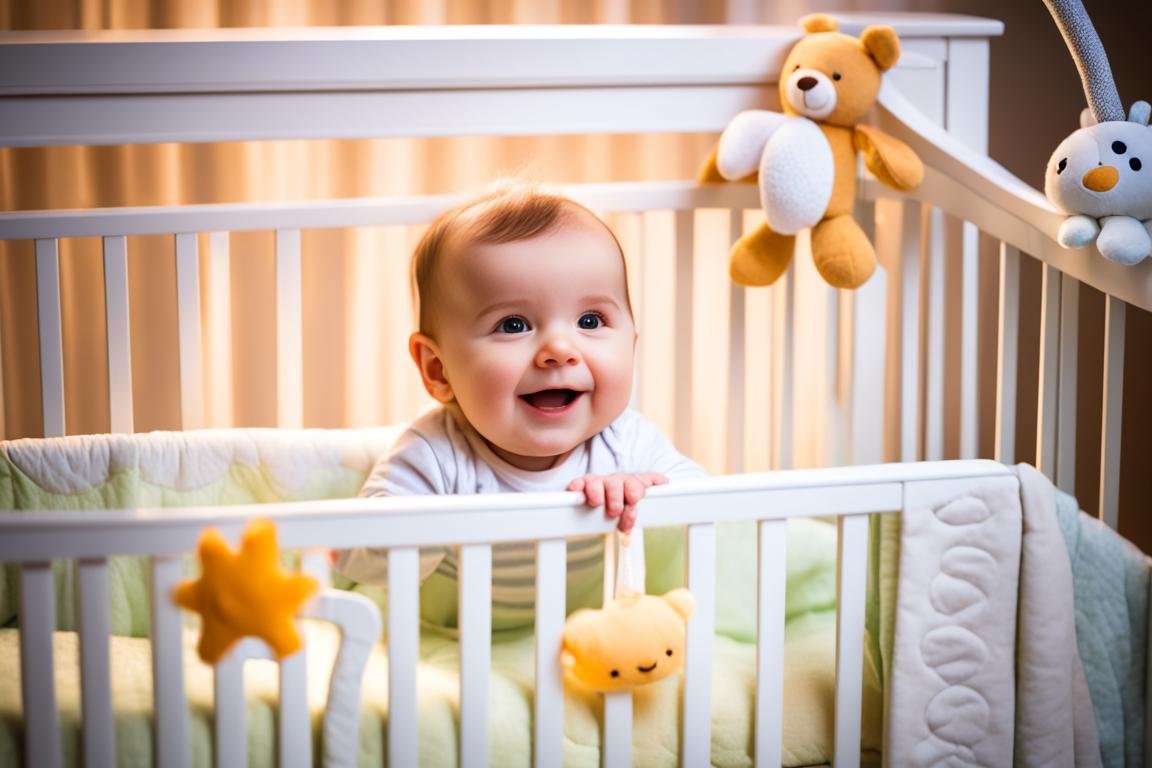Setting up a good sleep routine for your 9-month-old is very important for both of you. At this age, babies sleep about 12-16 hours a day. They have 10-12 hours at night and two daytime naps. But, sometimes things like sleep regressions happen and can mess up this routine. This can make parents and the baby upset. We’ll share some expert advice to make a peaceful bedtime tradition. We’ll talk about effective sleep training methods and how to fix common sleep issues. This will help your 9-month-old sleep better.
Key Takeaways
- Establishing a consistent bedtime routine is crucial for 9-month-old babies
- Sleep training can be effective at 9 months, but it’s important to avoid doing it during times of transition or illness
- Creating a calming sleep environment, such as a dark, cool, and quiet nursery, can help your baby sleep better
- Common sleep training methods for 9-month-olds include the wake-and-sleep method, pick-up/put-down, and the Ferber method
- Adjusting the bedtime routine as your baby’s needs change can help ensure they’re getting the 12-16 hours of sleep they typically require
Understanding Sleep Needs at 9 Months
By 9 months, babies usually sleep for about 14 hours daily. The normal range is from 12 to 16 hours. This time includes 10 to 12 hours during the night and two naps during the day.
Each nap can last one to two hours. But remember, every baby is different. Your baby might need more or less sleep. Watch your baby for signs they’re tired to learn their sleep needs.
Importance of Consistent Sleep Routines
Having a regular sleep routine is very important for 9-month-olds. They really like knowing what comes next. A calm bedtime routine can make them feel safe and help them sleep.
Sticking to a schedule helps babies fall asleep faster. They also tend to wake up less at night when they have a routine.
Signs It’s Time to Start Sleep Training
Most doctors say you can start sleep training your baby between 4-6 months. But, it can also be a good idea at 9 months. It might be time when your 9-month-old wakes up a lot at night and finds it hard to fall asleep. Also, if your baby’s bedtime tends to change, it could be a sign.
If your 9-month-old is having trouble sleeping, like taking a long time to fall asleep or waking up often, you might need more structure. A bedtime that changes a lot is another sign. This means some nights they sleep early, some late, making things less predictable.
It’s vital to look at what your child needs when thinking about sleep training. Talk to your doctor. They can help you figure out the right time and way to start training.
Preparing for Sleep Training
Starting to teach your 9-month-old to sleep well is a big step. It’s good to look at different ways to do it. Also, make the room calm for sleep. This will help your baby learn to sleep better now and in the future.
Choosing the Right Sleep Training Method
There are many ways to help your baby sleep better at 9 months. Each way is a little different. For example, the wake-and-sleep method teaches babies to soothe themselves. The pick-up, put-down technique calms them but helps them sleep on their own.
The chair method has you near when they sleep, moving farther each night. There’s also the Ferber method and the cry it out method. You let the baby cry, but each has its steps. Find one that works for you and your baby. It fits your style and what they like.
Creating a Calming Sleep Environment
The sleep place should be calming. It should be dark, cool, and quiet. Use white noise or sound machines to block outside sounds. Soft beds and smooth pajamas help make a cozy place. A before-sleep routine is good too. It tells your baby it’s almost time to sleep.
Sleep Training Methods for 9-Month-Olds
At 9 months old, finding the right sleep training method is key. It’s about what fits your baby and your family best. You can try the caring wake-and-sleep method or the Ferber method that is more structured. Both have good points to think about.
The Wake-and-Sleep Method
The wake-and-sleep method is soft at first. You wake your baby a bit, then let them snooze by themselves. It helps them learn to settle down alone, a big step in their sleep training. Always do your bedtime routine, feed, and burp them first. Then, tuck them in slightly sleepy but awake.
The Pick-Up, Put-Down Technique
The pick-up, put-down method is about calming your baby when they need it. Then, put them back to bed. They start to know they can sleep alone, which is great for later.
The Chair Method
The chair method has you by their side as they drift off. Each night, you move further away. It gives them comfort and helps them get used to falling asleep by themselves.
The Ferber Method
The Ferber method has a plan, called “graduated extinction”. It means letting them cry a bit, then longer before you help. This shows them they can calm down on their own.
The Cry It Out Method
The cry it out method is tough on both parents and baby. It’s when you let them cry until they sleep, without going in to help. Use this only if nothing else works.
Establishing a Soothing Bedtime Routine
Creating a calming bedtime routine is key for your 9-month-old’s sleep. At this age, babies need a set schedule. A bedtime ritual makes them aware it’s time to sleep. This includes activities like bathing, feeding, stories, and lullabies. Such practices greatly improve their sleep.
Elements of a Bedtime Routine
A nightly routine for a 9-month-old might start with a warm bath and comfy PJs. Then, they could have a feeding, read a book, hear a lullaby, and white noise. These steps, if done in order, help your baby know sleep is near. You can also add massages or rocking for extra relaxation.
Adjusting the Routine as Needed
As your baby grows, their sleep habits might shift. Flexibility in your bedtime routine is important. You might need to add or remove steps or change the routine time. Paying attention to your baby’s signals and adapting ensures they sleep well.
It’s important to stick to a soothing and regular bedtime routine. By being attentive to your baby’s needs and using effective methods, you’ll help them sleep soundly. A good bedtime schedule aids in their growth and well-being.
sleeping routine for 9 month old
Setting a regular sleep routine is vital for your 9-month-old’s health and growth. This often includes activities like a bath, story time, and calming sounds. It helps your baby know it’s time to rest. Make sure to notice your baby’s sleep signs and change the routine if needed. Babies this age usually need between 12-16 hours of sleep each day.
| Sleep Statistic | Recommended Amount |
|---|---|
| Wake Windows | 2.5–3.5 hours |
| Daytime Feedings | Every 2.5–3.5 hours |
| Daytime Sleep | 2.5-3.5 hours |
| Bedtime | 7:00-8:00 pm |
| Naps | 2 |
| Nap Duration | No single nap should exceed 2 hours |
| Night Sleep | 10-12 hours |
| Total Sleep | Around 14 hours (11-12 hours at night, 2-3 hours during the day) |
| Awake Time Between Sleep | 2.75-3.5 hours |
Creating a comforting bedtime routine helps your baby fall asleep better. Use familiar signals to tell your baby it’s bedtime. Yet, it’s also important to change the routine to fit your baby’s sleep needs.
Troubleshooting Sleep Issues
Sleep Regressions at 9 Months
At 9 months, many babies go through a sleep regression. They might find it hard to sleep or wake up a lot at night. This happens because of new skills like crawling or pulling up. These can throw off their baby sleep patterns.
Keeping the bedtime routine steady and not making big changes helps. It will pass as your baby learns new things.
Common Sleep Problems and Solutions
Problems at night for 9-month-olds can include trouble sleeping, waking often, and getting up early. To fix this, you might change their bedtime or make their sleep area more calming. Sleep training techniques that are gentle can also make a difference. They can teach your baby to calm themselves down when they wake up.
Creating a Healthy Sleep Environment
The key to a 9-month-old getting good sleep is a perfect sleep space. Make sure the room is the right temperature, dark enough, and quiet. This will make your baby’s sleep better and grow healthy sleep habits.
Optimal Room Temperature and Lighting
For a 9-month-old, the best sleep place is cool, dark, and quiet. Keep the room from 68-72°F. Use curtains to stop any extra light. This tells your baby it’s time to sleep.
White Noise and Soothing Sounds
A white noise machine is great for your baby’s sleep. About 80% of babies sleep in 5 minutes with white noise. Soft soothing sounds like lullabies or nature sounds work well too.
Keep the room just right for your 9-month-old’s sleep. Watch the room’s temperature, light, and noise. Doing this helps your baby sleep better and grow well.
Conclusion
Creating a calming bedtime routine is key for your 9-month-old’s health and growth. They usually sleep 12 to 16 hours a day, napping 2 to 3 hours. A steady bedtime routine lets your baby learn good sleep patterns.
Choose the best sleep training method, like the Wake-and-Sleep or the Ferber Method. Make sure the sleep area is relaxing. This includes having the right temperature, dim lights, and soft sounds. It will help your baby sleep well at night.
Each baby is different, so you might need to change your strategy. Stay patient and consistent. This will help your baby sleep better, now and in the future.




